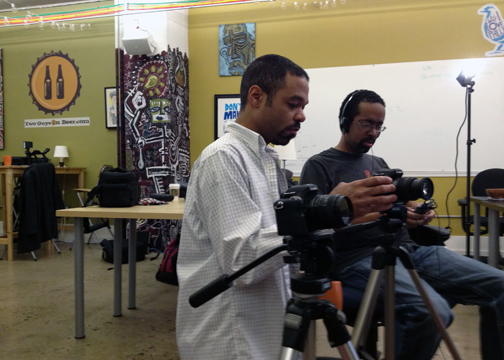In the eight-episode web series “Developing Philly,” filmmakers David Dylan Thomas and Maurice Gaston portray Philadelphia as a natural cradle for technology, tracing its lineage from the birth of the world’s first all-purpose digital computer — the ENIAC, at Penn in 1946 — through the ascent of state-backed investment firm Ben Franklin Technology Partners/SEP, Pete Musser’s legendary Safeguard Scientifics, the dot com boom and bust to present day.
The men behind the series — along with Meredith Broussard and Elliot Menschik, who make appearances in the documentary — were on hand Wednesday night at Callowhill incubator Venturef0rth for the unveiling of the first two episodes of the series, which are now live at DevelopingPhilly.com.
A new episode will premiere online each Friday through June 7. Watch the first episode below.
[vimeo 64730636 w=650 h=366]
“We thought we were going to be telling a story about technology, which turned into a story about business, which turned into a story about community,” Thomas said after the viewing.
As it turns out, the formation of community seems to be a natural output of the entrepreneurial process, because as one interview in the documentary says: “you can almost draw a family tree of startups” in the region, like in other growing communities.
Among several trees in Philly’s past, the first two episodes include one seeded at Infonautics, cofounded by Josh Kopelman and Marvin Weinberger in 1992. Lucinda Duncalfe came out of Infonautics to become president of Turntide and now RealFoodWorks, among others, Mike Krupit emerged to become president of CDNow and is active today, and Kopelman followed up his effort with Half.com before launching First Round Capital, which he manages today.
“There were at least 20 or 30 startups that spun out from the people involved with Infonautics,” said Krupit.
Then Thomas and Gaston describe a turning point: the dot com bust of this century’s beginning.
“In 1995 we all graduated from school and got dot com jobs. Then after the crash everyone was out of work,” said Meredith Broussard, now a professor at Temple. She balances her point with the observation that the bubble’s burst didn’t deter young professionals from continuing to move into Center City during the oughts, perhaps laying the groundwork for the bootstrapper-oriented element distinct to the scene of today.
By intricately exploring these threads of cause and effect throughout Philly tech’s major moments, Thomas and Gaston not only provide ample context, they insinuate it all has led up to the reemergence of the tech scene in present day. As felt from the onset of the project, having a cohesive narrative completed about a community is good for its identity, and the pair do a good job of creating that.
The challenge is to do so evenly and honestly — the ENIAC was a milestone for humanity, but today’s more organic, early-stage tech community is a very different, less historically relevant sort of watershed. The risk for the filmmakers is being too kind to what is, by almost any metric, a well-intentioned but very less prominent group that is likely having much less impact outside of Philadelphia.
It’s a rebuilding process. As Menschik pointed out following the viewing, today’s entrepreneurs often depend on the sturdy support of the shoulders of yesterday’s giants.
“Startup entrepreneurs of yore sew the seeds for the next generation of startups as mentors, investors,” he said, a good sign for Philly as faces from the 90s move back into the city.
In which case, maybe we all owe a little bit to Penn engineers John Mauchly and J. Presper Eckert, who developed the ENIAC.
“The ENIAC was big enough to fit a school bus comfortably inside,” says Mitchell P. Marcus, Ph.D at Penn. “I would like to stay the ENIAC was about as powerful as the watch on my wrist, but I think my watch wins.”







